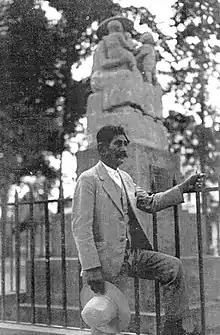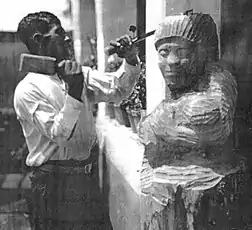Mardonio Magaña
Mardonio Magaña-Camacho (c.1865–1947) also known as Magañita,[1] was a Mexican educator and sculptor known for his folk art[2] stone direct carvings, he was also known to work with wood and mud. He was a self-taught artist inspired by nature, that was "discovered" by artist Diego Rivera.[1][3] It's said that Diego Rivera was quoted as saying Magaña was, "the greatest contemporary Mexican sculptor".
Mardonio Magaña | |
|---|---|
 | |
| Born | Mardonio Magaña-Camacho c.1865 Guanajuato, Mexico |
| Died | 1947 Mexico City, Mexico |
| Nationality | Mexican |
| Known for | wooden direct carved sculptures |
| Style | contemporary Mexican folk art |
Biography

Born between 1865 and 1866 in La Estancia Nueva, Guanajuato, Mexico to a peasant family, the son of Dolores Camacho and Jacinto Magaña.[3][4] He spend most of his life working as a foreman at the property of Don Vincente Silva in his hometown.[5] At age 52, after the devastation left by the Mexican Revolution he moved to the capital, Mexico City to find work.[3] And in 1921, while working at an art school called Escuela de Pintura al Aire Libre de Coyoacán (English: School of Outdoor Painting in Coyoacán) as a janitor, he started creating sculptures.[3][5] Between 1925–1928 he becomes a general caretaker for the school and by 1929 he is promoted to professor of sculputure.[5] Throughout the 1930s he held various teaching positions in Mexico.[5]
Magaña's artwork is included in museum and private art collections internationally some of which are; Philadelphia Museum of Art,[6] Museum of Modern Art (MoMA),[7] National Museum of Mexican Art,[8] the Nelson A. Rockefeller Collection,[9] and Frida Kahlo Museum.[10]
Magaña's portrait was painted by Diego Rivera in his large mural Pan American Unity (1940)[3] and can be seen at the City College of San Francisco, where the mural is now located.
References
- "AFTER THE TRACE: Mardonio Magaña, the revaluation of an artist". Proceso.com.mx (in Spanish). 2004-03-04. Retrieved 2017-07-16.
- Grimes, William (2015-05-21). "In 'Frida Kahlo: Art, Garden, Life,' Nature Melds With the Artist Herself". The New York Times. ISSN 0362-4331. Retrieved 2017-07-16.
- Orozco, Gisela (2012-02-03). "Hoy: Mardonio Magaña: The peasant sculptor". Chicago Tribune (in Spanish). Retrieved 2017-07-16.
- Rodríguez-Prampolini, Ida; Sabau-García, María Luisa (1994). México en el mundo de las colecciónes de arte: México contemporáneo (in Spanish). Mexico: UCOL. ISBN 9686963421.
- Reyes, Dolores. "Mardonio Magaña Chronology". The Portal to Texas History. University of North Texas (UNT). Retrieved 2017-07-17.
- "- Collections : Mardonio Magaña". Philadelphia Museum of Art. Retrieved 2017-07-18.
- "Mardonio Magaña". The Museum of Modern Art, MoMA. Retrieved 2017-07-18.
- "Mardonio Magaña: Circa 1938". National Museum of Mexican Art. Retrieved 2017-07-18.
- Oettinger Jr., Marion (2010). Folk Treasures of Mexico: The Nelson A. Rockefeller Collection. Arte Publico Press. ISBN 161192149X.
- "Fireclay Debuts Tile Inspired by Frida Kahlo's Casa Azul | Architectural Digest". Architectural Digest. Retrieved 2017-07-16.